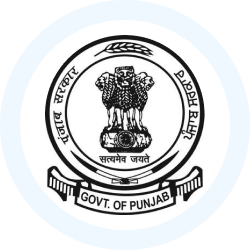Arts, Crafts and Culture of Punjab | Punjab State (PPSC) PSC: Preparation - PPSC PCS (Punjab) PDF Download
Introduction
Punjab is home to a diverse range of handicrafts created by skilled artisans, including the talented rural women who contribute significantly to these beautiful artworks. One of the most prevalent forms of art in Punjab is painting, with nearly every small village and town showcasing their unique creations.
Mudwall and Mural Paintings
- Mudwall and mural paintings are particularly famous in Punjab.
- These paintings often depict scenes of bravery, the teachings of gurus, traditional sports, and aspects of daily life such as religious customs and historical battles.
Mural Paintings in Punjab
Mural paintings are artworks created on fixed surfaces such as gateways, ceilings, and walls. In Punjab, older cities like Patiala, Amritsar, Gurdaspur, Kapurthala, Faridkot, and Hoshiarpur boast remarkable historical buildings adorned with a rich collection of wall and mural paintings.
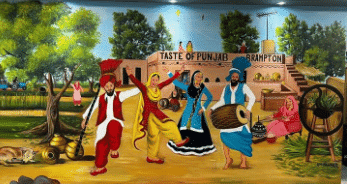
Notable Locations
- Hoshiarpur: Bairagas’ Thakar Dwara is filled with wall and mural paintings depicting socialist themes.
- Kapurthala: The Shekuhpua temple, commissioned by Diwan Saudagar Mal, features a chamber surrounded by a trail of diverse mural and wall paintings.
- Holy Sites: Places like Harmandir Sahib (Golden Temple), Tower of Baba Atal Rai, Ranjit Singh Museum, and Akhara Bala Nand showcase some of the finest paintings.
Harmandir Sahib
- The Golden Temple, or Harmandir Sahib, is home to around 300 striking works of art.
- These paintings primarily depict stories from religious texts such as the Mahabharata, Ramayana, and traditional love stories of Punjab.
Patiala District
- Qila Mubarak Androon: This site is known for its wealthy collection of paintings and artworks.
- Sheesh Mahal: This location exhibits rare paintings of Shri Guru Nanak Dev Ji, the first Guru of the Sikhs, and Sikh royalty.
Mudwall Paintings
Mudwall paintings showcase the incredible creativity of Punjabis in transforming plain surfaces into stunning works of art. This traditional art form, known as Chowk-Poorna, involves plastering house walls with mud and then adorning them with vibrant and intricate designs. Historically, it was the women of Punjab who would draw these captivating paintings on the walls. In rural Punjab, mudwalls are often painted during festive occasions such as Dussehra, Karva Chauth, Holi, Diwali, and others, adding a festive touch to the homes.
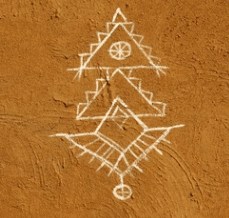
Forms of Craft
Punjab is home to a diverse range of crafts, each flourishing in different parts of the region. Some of the major forms of craft include:
- Basketry
- Durries (rugs)
- Paranda (braided hair accessories)
- Toys
- Metal craft
- Weaving and embroidery
- Leather craft
- Punjabi phulkari (embroidered shawls)
- Woodcraft
- Juttis (traditional footwear)
- Jewellery making
- Traditional dress making
Basketry in Punjab
Basketry is a well-known handicraft in many parts of Punjab. Artisans weave together thick, flexible grass straw called Osier Bast or Sarkanda with materials like bast, reeds, rushes, and corn husks to create various products.
- Hand Fans: The Peshawari Pankkha is a popular handmade fan, while smaller, more delicate fans called Kundaladar Pankkhi have curled ends.
- Chhaj: This is used for separating grain from husk and is also made from Sarkanda.
- Household Articles: Sarkanda is interwoven with coloured cotton threads to create items like chiks, bohey, pitarian, and a type of chair known as Moorras.
- Dowry Items: Women craft baskets in various shapes and colours to hold pins, cotton, buttons, needles, and threads, which are included in dowries.
Folk Toys of Punjab
Folk toys are a beautiful blend of creativity and cultural values. The history of handmade toys in Punjab dates back to the Indus Valley Civilization, which existed between 2500 to 1700 BCE. During this period, some of the most notable toys included small terracotta carts and rattle boxes.
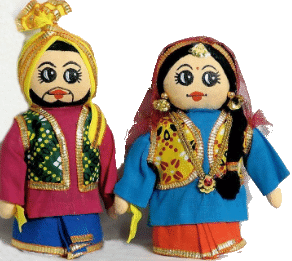
Folk toys from Punjab come in various designs and shapes, representing different aspects of life and culture. These toys depict wheeled vehicles, animals, birds, and traditional dancers, showcasing the vibrant culture of Punjab.
There is also a division of folk toys based on gender. Girls can find toys like chulas (stoves), handis (pots), tawas (griddles), and dolls, while boys can choose from toys like carts, tractors, guns, and spinning wheels.
These folk toys not only reflect the artistry of the region but also represent the daily life and traditions of Punjab in a unique and engaging way.
Doll Making
- Doll making is a vibrant and culturally rich tradition in Punjab, primarily carried out by women.
- The process involves meticulous attention to detail to ensure that the dolls accurately represent their original forms.
Materials Used
- The main materials used for making dolls in Punjab are cloth and cotton.
- In addition to these, glittery materials are often used to create embellishments such as turbans and chunris.
Purpose and Use
- The dolls produced in Punjab are used for various decorative purposes in homes, offices, and public spaces.
- They are also popular in the hospitality industry, as they add a lively and vibrant touch to different settings.
Chandigarh: A Hub for Doll Making
- Chandigarh has emerged as a significant centre for doll making in Punjab, contributing to the preservation and promotion of this traditional craft.
Leather Craft in Punjab
Punjab is renowned for its exquisite leather craftsmanship, producing a variety of items such as handbags, juttis, kohlapuris, and khusa shoes. These products are not only popular within Punjab but have also gained recognition in other states across India.
Punjabi Juttis
- Intricate Designs: Punjabi juttis are famous worldwide for their detailed and intricate designs.
- High Quality: The quality of these handmade shoes is exceptional, and it has been maintained over time.
- Materials: Although gold and silver wires were traditionally used, they have been replaced by gold and silver threads in the making of these juttis.
- Lightness: The lightness of these shoes is legendary, making them comfortable and easy to wear.
Production Areas:
- Patiala and Muktsar: These districts in Punjab are particularly famous for producing Punjabi juttis.
- Rajasthan and Haryana: Punjabi juttis are also manufactured in these neighboring states.
Metal Craft in Amritsar
Amritsar, a district in the state of Punjab, is renowned for its exquisite metal work. In particular, a place called Bhandian within Amritsar is famous for its bustling bazaar, where a wide variety of utensils in different shapes and colors are available.
The artisans involved in metal work during the early days of this craft in Amritsar were known as Chiteras. These skilled craftsmen utilized various techniques such as casting, soldering, and decoration to create a range of metal products. Some of the decorative techniques employed include pierced work, chasing, and engraving.
The district produces a plethora of items including metal pots, utensils, and objects used for religious rituals such as lamps and trumpets. Additionally, decorative items like lamp shades and intricately engraved metal doors are made in abundance. The figurative engraved panels found in temples and gurdwaras are also in high demand.
Weaving and Embroidery
Punjab is renowned for its rich tradition of weaving and embroidery, which is celebrated and sought after worldwide. Embroidery involves decorating fabrics using a needle and colorful thread or yarn, often incorporating fancy materials like pearls, small mirrors, beads, quills, and jewels.
Common patterns in Punjabi embroidery include stripes, chessboards, squares, and motifs of birds, animals, and plants. Punjabi weaving is distinguished by its unique needlework, which sets it apart from other forms of embroidery. Famous forms of weaving and embroidery in Punjab include Phulkari, durries, and parandas.
Phulkari, meaning “flower work,” involves embroidering the entire field of cloth with flowers. This art form is used to create exquisite designs on shawls, dupattas, and headscarves. Phulkari is typically woven with silk threads on colored cotton cloth. In some cases, the entire cloth is covered with dense designs, making the ground cloth invisible.
Phulkari can be categorized into different styles, including Bagh and Chope.
- Bagh: This style covers the entire surface of the cloth with floral embroidery using contrasting silk threads. The designs are created using horizontal, vertical, and diagonal stitches.
- Chope: In this style, embroidery is done on handspun red khaddar with golden yellow threads, using small squares in a step-ladder fashion.
The colors used in Chope embroidery carry symbolic meanings: red for passion, yellow or golden for desire, white for purity, green for fertility and abundance, blue for calmness, and orange for divine energy. High-quality phulkari work is particularly noted in Amritsar and Firozpur.
Durries
Durries, also known as cotton bed and floor spreads, have been lovingly woven by young girls in Punjab for generations. These flat woven rugs are not only functional but also visually striking, making them a cherished part of Punjabi culture. Durries can be used as carpets on the floor or as bed covers, and what sets them apart from ordinary carpets and bed covers is the intricate blend of artistic designs that adorn them.
Paranda
Paranda is a traditional handicraft from Punjab that holds cultural significance. It is a colorful hair accessory worn by Punjabi women, who typically have long hair. They braid their hair and tie a paranda at the end of the braid. Parandas come in a wide variety of designs and colors and are made from a bunch of silk threads woven together with other skilled craftsmanship. The Patiala paranda, similar to the famous Patiala salwar, is particularly well-known throughout Punjab.
Wood Craft in Punjab
Punjab is famous for its artistic woodwork. Punjabi carpenters are skilled in creating strong, durable, and visually appealing furniture. They are particularly known for making creative beds with mirrors on the back and beautifully carved, colorful legs called Pawas.
The craftsmen in Punjab are experts in various woodcraft techniques, including wood finishing, wood mirror work, wood engraving, and ivory inlaying. A significant amount of furniture, boxes, toys, and decorative items made from wood are exported from Punjab. The regions renowned for woodcarving in Punjab include Batala, Amritsar, and Hoshiarpur.
Pidhis
- Pidhis are small wooden stools adorned with intricate carvings and designs crafted by skilled artisans. These stools are used by Punjabis to add a touch of tradition to their homes, blending seamlessly with modern furniture.
- Pidhis are primarily made in Hoshiarpur, Jalandhar, and Kartarpur, although artisans with expertise in creating these traditional pieces can be found throughout the state.
Paper Mesh Work
In this form of art, old papers that are considered trash are mixed with mud to create a dough-like mixture. This mixture is then used to craft various items such as baskets, containers, and toys.
Culture of Punjab
Punjab boasts one of the most unique and ancient cultures in the world. Its traditional clothing, jewelry, and cuisine are key elements that promote Punjabi culture globally.
Traditional Dresses of Punjab
For Women:
- Churidar and Kurta: This is the most common outfit among Punjabi women.
- Salwar Kameez: Another popular traditional costume in Punjab.
For Men:
- Kurta and Pajama: This is the traditional dress for Punjabi men.
- Tehmat or Lungi with Kurta: Some men also wear the traditional tehmat, which is a type of lungi, along with a kurta.
- Pug or Pagdi: This unique headgear is a symbol of religion and respect for the Guru.
- Jutti: Traditional shoes that are part of the Punjabi men's dress.
Jewelry of Punjab
Punjab is known for its rich and diverse jewelry tradition, featuring a wide array of designs in bangles, necklaces, rings, earrings, nose pins, hair ornaments, anklets, and toe rings. Both men and women in Punjab adorn themselves with traditional ornaments that vary in style and significance.
Ornaments for Men
- Head/Forehead Ornaments: Include Sarpesh, Kutbiladar, Mukat, and Mutakh.
- Ear Ornaments: Feature Bala, Murki, Dur, Birbali, and Durichah.
- Neck Ornaments: Such as Mala, Kanth-kanti, Nam, Tawiz, Takhti, Zanjiri, and Chandarmah.
- Hand Ornaments/Bracelets: Include Ponchi, Kangan, Kara, or Gokru.
Ornaments for Women
- Head/Forehead Ornaments: Include Sagi Phul, Chowk, Dand, Borla, Baghiar, Shingar Patti, Tikka, Clip, Mauli, Sir Mang, Damni or Dauni, Chand Bina, Tawit, Jhumar, Guchhi Marwarid, Bindi, and Barwata.
- Ear Ornaments: Feature Kante, Bunnde, Pipal, Lotan, Bujilian, Tungal, Sone-chirian, Kokru, Jhumke, Valian, Dandlian, Rela, Bhadurnian, and Murkian.
- Nose Ornaments: Include Teeli, Koka, Rekh, Laung, Nath-Machli, Nukra, Latkan, Morni, and Phuli.
- Necklaces/Neck Ornaments: Such as Chandanhar, Mala, Champakali, Jugni, Mohran, Haul Dil, Hassi, Guluband, Mohanmala, Atradan, Kandi, Silwatta, Tanderay, Gaani, Hanela, Taga, Taweet, Chaunki, Chatkala, Locket, Pandal, Dholne, Tabeet, Bughatian, Ranihar, and Kannarsaini Haar.
- Feet Ornaments: Include Patrian, Zanjeeran, Vale Lache, Shahkuntla Chain, Panjeba, Kunjlidar Tore, Bankan, and Jhanjran.
- Arm Ornaments: Such as Bazuband, Nauratan, Taviz, Anant, and Bhawatta.
- Bracelets: Include Ponchian, Kangan, Banka, Gajra, Churi, Bain, Band, and Jhankangan.
- Finger Ornaments: Include Anguthi, Challa, Angutha, Khari, Shahelmi or Khari, and Birhamgand.
- Hand Ornaments: Feature Panj Angla, Rattan Chowk, Hath-phul, Aarsi Mundrian, Kalichian, and Chale.
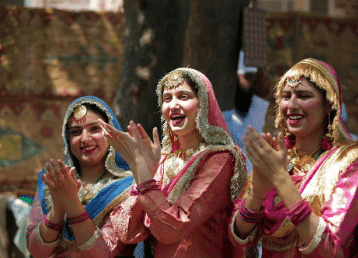
Cuisines in Punjab
Punjabi cuisine is renowned for its deliciousness, which comes from the rich spices and the generous use of Desi Ghee. This cuisine offers a wide variety of both vegetarian and non-vegetarian dishes. Roadside eateries known as dhabas are especially popular in Punjab.
The people of Punjab primarily eat wheat-based foods, but rice is reserved for special occasions and festive celebrations. Punjabi dishes are characterized by the abundant use of ginger, garlic, and onion, which add depth and flavor to the curries. Dairy products also play a crucial role in the Punjabi diet.
Here are some of the famous cuisines of Punjab:
Aloo Paratha:
- Aloo Paratha, or Aaloo da Paratha in Punjabi, is a popular breakfast dish in Punjab.
- It features stuffed parathas with fillings such as potatoes, cheese, or cauliflower.
Chole-Bhature:
- Chole-Bhature is a famous dish from Punjab, consisting of chana masala (spiced chickpeas) served with bhatura, a fried bread made from maida flour (soft wheat).
Punjabi Lassi:
- Lassi is a beloved drink in Punjab, made from curd and milk.
- It is thick, creamy, and consumed with breakfast or lunch.
- Punjabi Lassi is a healthy drink without artificial flavors.
Sarson ka Saag with Makki di Roti:
- This traditional winter dish features green mustard leaves and spinach, enhancing both the nutritional value and taste of the saag.
Butter Chicken:
- Butter Chicken, or murg makhani, is a famous Punjabi dish made with tandoori chicken cooked in a creamy, buttery tomato gravy.
- It is often served with naan or kulcha.
Tandoori Chicken:
- Punjab is known for its authentic tandoori food, and Tandoori Chicken is a prime example.
- The chicken is marinated with spices and curd, then grilled in a tandoor, making it a popular starter before the main course.
Amritsari Machchi:
- Despite being landlocked, fish is a favorite food in Punjab, particularly in the form of deep-fried and skewered dishes.
- Amritsari Machchi is a popular dish featuring crispy fried fish fillets coated in a spiced gram flour batter, deep-fried, and sprinkled with chaat masala.
|
23 videos|50 docs|47 tests
|
FAQs on Arts, Crafts and Culture of Punjab - Punjab State (PPSC) PSC: Preparation - PPSC PCS (Punjab)
| 1. ਪੰਜਾਬ ਦੇ ਮੂਰਤੀ ਚਿੱਤਰਕਾਰੀ ਦੇ ਪ੍ਰਕਾਰ ਕੀ ਹਨ? |  |
| 2. ਮੱਡ ਵਾਲੀ ਚਿੱਤਰਕਾਰੀ ਕੀ ਹੈ ਅਤੇ ਇਸਦਾ ਮਹੱਤਵ ਕੀ ਹੈ? |  |
| 3. ਪੰਜਾਬ ਵਿੱਚ ਬਾਸਕੀਟਰੀ ਦੇ ਸਿਰਜਣਹਾਰ ਕੌਣ ਹਨ? |  |
| 4. ਪੰਜਾਬ ਦੇ ਲੋਕ ਖਿਲੌਣਿਆਂ ਦਾ ਕੀ ਮਹੱਤਵ ਹੈ? |  |
| 5. ਪੰਜਾਬ ਵਿੱਚ ਚਮੜੇ ਦੇ ਕਾਰੇਗਰੀ ਦੇ ਪ੍ਰਕਾਰ ਕੀ ਹਨ? |  |




